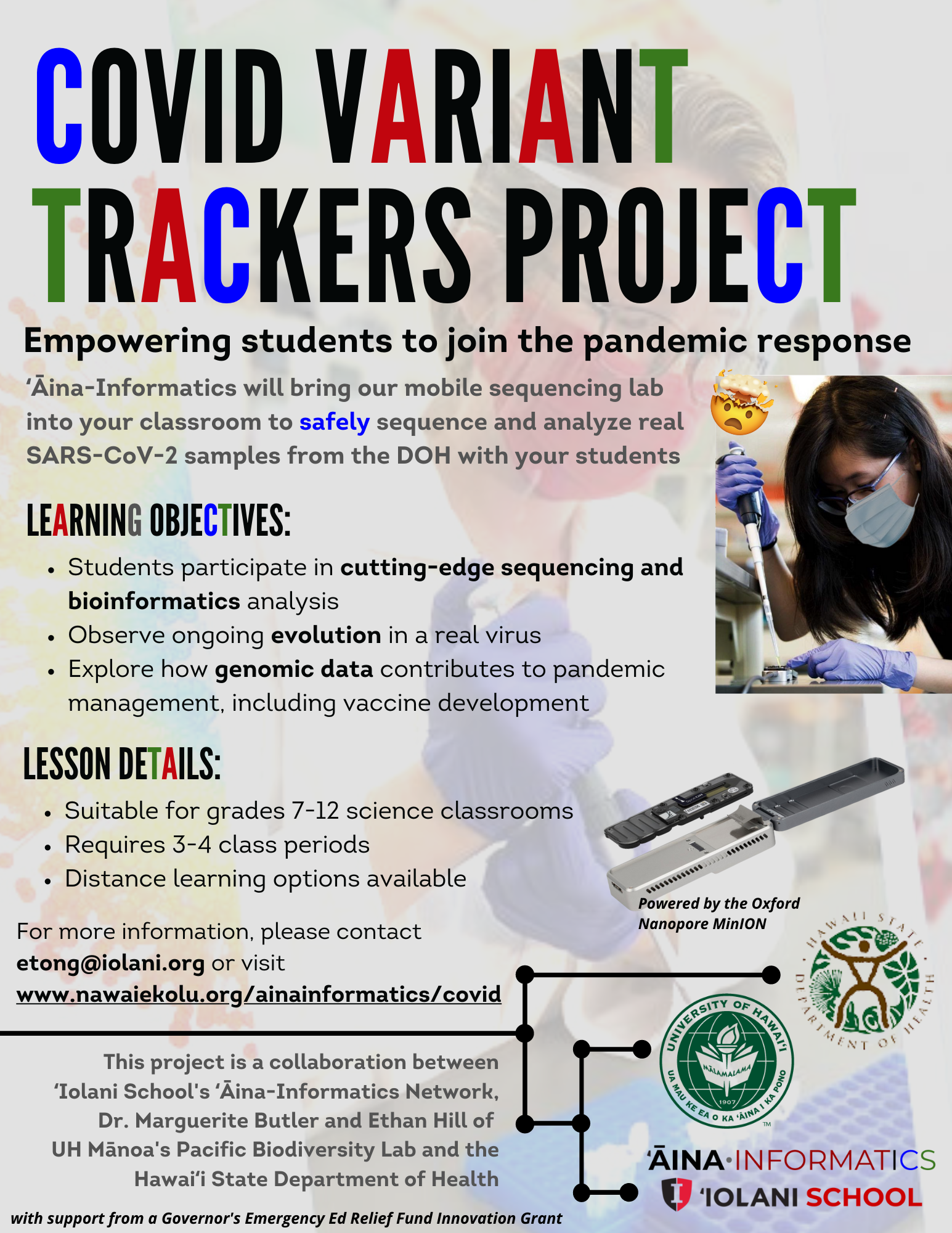Sequencing SARS-CoV-2 in your classroom
As the COVID pandemic extends into its second year, a number of variants of interest and concern have evolved from the original SARS-CoV-2 virus.
As the onset of the delta phase of the pandemic has shown, it is not enough to track the virus by case counts and contact tracing alone - we need to understand at a genetic level what variants are where, and what makes them more or less virulent. In Hawaiʻi, the agency tasked with genomic surveillance of the coronavirus is the State Department of Health (DOH).
Using deactivated samples sourced from the DOH testing lab, students now have the opportunity to safely contribute towards the sequencing and analysis of real viruses swabbed from local patients using the MinION. The genomes can then be analyzed alongside publicly available sequences (GISAID) from Hawaiʻi in order to reconstruct the virus’ evolutionary and transmission paths through the islands.
Contact etong@iolani.org for more information.
WHAT IS A VARIANT?
How does COVID genomic surveillance in Hawaiʻi work? What can the virus’ genome tell us about how COVID is circulating through our islands? How can local students contribute to ongoing tracking of SARS-CoV-2 variants in Hawaiʻi?
Our UH Mānoa partners, evolutionary biologists Ethan Hill and Dr. Marguerite Butler, answered these questions and more at our recent STEMplus event.
WHERE ARE THE VARIANTS?
Where can students explore the latest data on the distribution and relative proportions of SARS-CoV-2 variants? Check out some of these tracking resources that are being used to inform both local and global responses to the pandemic. What is incredible about this project is that student-generated data will be fed back into these local, national and global databases for use by agencies around the world.
The Centers for Disease Control and Prevention COVID Data Tracker - Variant Proportions
Hawaiʻi Department of Health Disease Outbreak Control Division - Variant Reports
Every 2 weeks, the Hawaiʻi Department of Health also releases its latest Variant Report, which documents the identity and proportion of variants circulating in Hawaiʻi.
Nextstrain - Real-time Tracking of Pathogen Evolution
For a global perspective, explore Nextstrain’s genomic epidemiology of SARS-CoV-2 using all publicly available genomes (GISAID) reported from labs around the world.
Nanopore sequencing technology
Students gain exposure to one of the key DNA sequencing platforms being deployed to track the pandemic, the Oxford Nanopore MinION. Its portability and its relative cost are features that also make it suitable for the classroom. This video highlights some real life case studies that relied on nanopore technology to generate the genomic data used to inform pandemic responses all around the world.
Our partners
This project is a collaboration between ʻĀina-Informatics, Dr. Marguerite Butler and Ethan Hill (University of Hawaiʻi at Mānoa, Pacific Biodiversity Lab) and the Hawaiʻi Department of Health. Mahalo nui loa to the DOH for supplying samples, and to Ethan and Dr. Butler for providing the expertise and content for this curriculum.
Dr. Marguerite Butler is an evolutionary biologist and the principle investigator of the Pacific Biodiversity Lab at UH Mānoa.
Ethan Hill is a graduate student in the Butler Lab at UH Mānoa investigating the evolution of SARS-CoV-2 in Hawaiʻi.
Dr. Edward Desmond is the Laboratory Director of the State of Hawaiʻi Department of Health’s Public Health & Environmental Laboratories.
WITH GENEROUS support FROM
A Governor’s Education Emergency Relief Fund Innovation Grant
For more information, please visit the ʻĀina-Informatics Network homepage.












